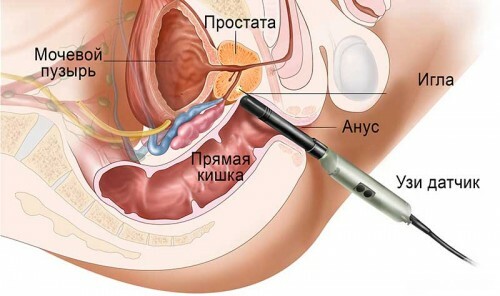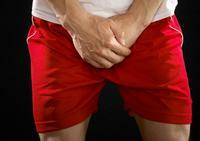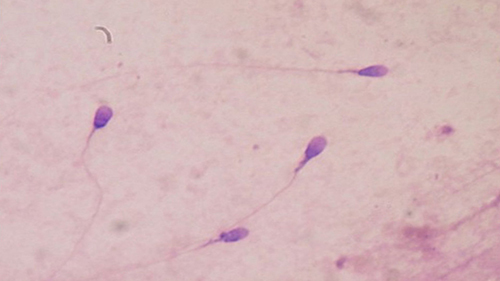How is prostate biopsy performed?
Prostate biopsy is recognized as the leading method for the diagnosis of cancer and other prostate cancers. The study allows you to accurately diagnose, assess the prevalence of the tumor, the degree of its differentiation and the stage of the development of the disease. Based on the results of the biopsy, a treatment regimen is developed and further tactics of the patient's management is determined.

Biopsy prostate
content
- 1 Indications
- 2 Contraindications
- 3 Preparation
- 4 Technique
- 4.1 Transrectal Prostate
- 4.2 biopsy transurethral prostatic biopsy
- 4.3 Transperineal
- 5 prostate biopsy Observation after biopsy
- 6 Complications
Indications
prostate biopsy is shown in the following situations::
- detection of suspicious neoplasms in digital prostate examination;
- tumor detection in TRUS( transrectal ultrasound study of the prostate);
- increase in the concentration of PSA( prostatic specific antigen) - a marker of cancer and prostate adenoma;
- histological diagnosis of the diagnosis( stage of the pathological process) with established prostate cancer( according to TRUSD).
During the biopsy, the doctor can determine the stage and prevalence of the process, clarify the nature of the tumor and assess the rate of its growth. Indications for the procedure are determined by the urologist after the examination and initial examination of the patient.
Contraindications
Prostate biopsy is not performed in the following conditions:
- infectious diseases in the acute phase;
- acute inflammatory diseases of the prostate, urethra and rectum;
- pathology of the blood coagulation system, which can not be corrected by medication.
Contraindications to biopsies can be detected by a urologist during a primary examination or during an additional examination.
Preparation of
Before the biopsy, the doctor briefly tells the patient how to perform it, focusing on the sensations arising during the procedure. The doctor must notify about possible complications of the biopsy and give recommendations on their prevention. If you have any questions, ask your doctor before the procedure begins.

Before the procedure it is necessary to make an enema or use a purgative laxative
Direct preparation for the procedure includes:
- 3-5 days before the biopsy, stop taking medications that affect the hemostatic system( as agreed with the doctor).
- For 3 days before the procedure, the use of anti-inflammatory drugs( paracetamol, ibuprofen, aspirin, etc.) is excluded.
- In the evening on the eve of the procedure it is recommended to make a cleansing enema.
- Do not eat before handling. You can drink water without gas.
- On the day of the procedure starts taking antibacterial drugs( for the prevention of bacterial complications).Antibiotics should be drunk within 5 days( unless the treating physician has given other recommendations).
Technique for running
Prostate biopsy is performed on an outpatient or inpatient basis. The procedure is performed under general or local anesthesia. All manipulations under anesthesia are done strictly on an empty stomach. In case of local anesthesia, it is recommended to refrain from eating for 4 hours.
There are three options for the procedure:
Transrectal biopsy of the prostate
Patient position: knee-elbow or on the side with knees bent or on the back with support on the footrest.
Biopsy is performed through the anus( rectum).The doctor injects a flexible probe through the anus and brings the instrument to the area of the prostate localization. A thin needle is used along the probe. Through the wall of the intestine, the needle enters the prostate tissue, after which the doctor takes the material for examination. During the biopsy, several samples from different parts of the prostate are taken to get the most complete information about the condition of the organ. The resulting material is sent to the laboratory for histological examination.
Transurethral prostate biopsy
Patient position: on the back.
The procedure is performed through the urethra( urethra).The doctor enters a flexible probe into the lumen of the urethra, penetrates the prostate gland and takes the material for examination. The procedure is often combined with urethroscopy - examination of the urethra by a special urethroscope probe.
Transperineal prostate biopsy
Patient position: on the side or back with bent legs.
Manipulation is performed through the perineum. The doctor makes a neat cut of the skin and underlying tissues of the perineum, and then introduces through the hole formed tool. Using a needle, the doctor takes the material for examination. Transperineal access is used for stenosis( constriction) of the anus and other conditions when it is not possible to insert the instrument through the rectum.
By modern standards, prostate biopsy is performed under the control of transrectal ultrasound( TRUS).This approach allows you to take material from the most suitable points and reduces the likelihood of complications after the procedure.
Follow-up after biopsy
During the procedure, the patient may feel some discomfort in the area of the anus and perineum. It is not ruled out that there is an easy soreness when the needle penetrates into soft tissues. Strong pain should not be. If severe pain occurs, tell your doctor immediately.
If the manipulations were performed under local anesthesia, the patient can stand up immediately after the completion of all manipulations. During the day, it is recommended to avoid physical exertion, do not lift weights, do not overexert. If the procedure was performed under anesthesia, the patient will have to spend 2 hours in the aftercare room under the supervision of a doctor.
Consequences of biopsy:
- slight soreness in the anus, perineal, urethra( depending on access);
- appearance of blood impurities in sperm and urine;
- slight bloody discharge from the rectum( with transrectal access);
- general weakness and increased fatigue( during the day).
All these symptoms persist for 3 days and are considered normal after prostate biopsy. Most men tolerate the procedure quite well and can return to the usual rhythm of life the very next day. If the biopsy was performed under anesthesia, recovery may take a little longer.
Complications of
Prostate biopsy is an invasive procedure that involves instrumental intervention in the body. After manipulation, it is possible to develop such complications of :
- bleeding from the urethra, bladder or intestine;
- infection( inflammation of the prostate, urethra, rectum);
- urinary retention;
- allergic reaction to the drugs used for anesthesia.

For severe pain in the groin and urinary retention, see a doctor immediately
Complications of the biopsy occur rarely, which allows the procedure to be performed on an outpatient basis( without admission to hospital).
How to understand that the procedure went through with complications? The following symptoms of indicate the development of adverse events:
- an admixture of blood in the urine or semen that persists for more than 3 days;
- profuse bleeding from the rectum;
- severe pain in the urethra, perineum, anus;
- body temperature rise above 37.5 ° C;
- appearance of pus in the urine;
- inability to self-urinate after 8 or more hours after the procedure;
- appearance of skin rash( a sign of an allergic reaction).
Read on: Proper nutrition for prostate cancer and other organ pathologies
Recommended for viewing:


